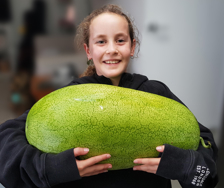Yates Account
Join now
Create a Yates account today!
Sign up to join the Yates Garden Club for monthly e-mails packed with seasonal inspiration, tips for success & exclusive promotions.
Plus if you’re a Garden Club member you can take part in the Yates Growing Community - a blog to share successes, get advice & win prizes in fun challenges along the way!

Forgot password
Enter the email address associated with your account, and we'll email you a new password.

Bees are a vital part of our ecosystem due to their great ability to pollinate a huge range of trees, native plants, flowers, fruits, vegetables and more.
Why are bees important?
Pollination occurs when pollen produced in the anther of a flower is physically moved to the stigma of another flower. Without this, plants can't reproduce by seed. Pollination is a wonderful unintended result of bees collecting pollen for their own livelihood. It’s a win-win situation!
These plants then support other insects, which support the birds, mammals and animals that eat them, all the way up to the food chain to where us humans are. Almost 90% of wild plants and 75% of global crops are reliant on animal pollination, resulting in pollination being responsible for at least 1 in every 3 bites we take!

Why do bees need nectar and pollen?
In order to survive and thrive, bees need to collect both nectar and pollen. The nectar from flowers helps give bees energy, whereas pollen provides the bees with protein and other vital nutrients. Bees will bring pollen back to their nest where it’s commonly used as food for their larvae. As part of the pollen collecting process, bees will spread pollen from one flower to another, and so on - which is largely how these plants are pollinated.
How do bees transport pollen?
There’s a wide range of different bee species, and a few different ways that they transport pollen.
Some bees have pollen 'baskets' that they use to store pollen as they fly between flowers.
Other bees have particular sticky and long leg hairs called 'scopae' that carry a slight positive electrostatic charge, that attracts negatively charged pollen. If you’re feeling brave and find a bee nearby, have a close look and see if it's covered in bright yellow pollen!
Some bees, such as the yellow faced bees or masked bees, actually carry pollen internally! These bees lack the normal hairy look that we commonly see on honeybees.
Do all bees transport pollen? No! Outside NZ, cuckoo bees have a completely different habit. They don’t have either pollen baskets or scopae; instead they survive by raiding the nests of pollen collecting bees and leaving their eggs behind. Their pupae emerge and feast on pollen stored by their hardworking hosts.

NZ native bees
New Zealand has 28 native bee species, with 27 of them being found only here.
Globally, there are 20,000 known bee species. Australia has over 1500 native bee species and the United States has over 4000.
Our native New Zealand bees spend most of their day gathering nectar and pollen. Most of these 28 species are solitary, which means they don’t have a large hive like the introduced honeybees you might see more commonly. Instead, they nest in small holes in the soil, often with nests grouped together in one area.
Our native bees rarely sting and are mostly non-aggressive. They're smaller than honeybees and bumblebees and are generally black in colour. They mostly pollinate our native plants such as Pohutukawa and manuka, but have quickly adapted to also pollinate some introduced flowers, such as ragwort.
Want more bees?
After reading about how important and vital are bees to our ecosystem, you’re probably wondering how to get more into your garden! Believe it or not, bees see very differently to humans, being able to see blue, green and UV light. This is a great help to them, as many flowers stand out under UV light, helping guide bees to their pollen and nectar.
Tips for planting to attract bees:
- Plant clusters of the same flowering species.
- Plant flowers for each season. A steady source of nectar and pollen all year round will help attract bees to set up nearby.
- Select 'single' flowers rather than 'doubles' or flowers with complicated petals (singles make better landing pads).
- Choose simple traditional flowers that aren’t bred to be unusual colours.

Pollinator attracting plants:
There are many plants and flowers out there that can help attract bees and other pollinators to your garden, but here are some of our personal favourites!
- Annuals – alyssum, cosmos, calendula, phacelia, sunflowers, echinacea, zinnia
- Perennials – daisies, salvias, forget-me-nots, nasturtiums, echium, California poppy & nigella
- Herbs (when in flower) – lavender, rosemary, oregano, borage, basil, dill, parsley and thyme
- Trees & Shrubs – all stone fruit & pip fruits, citrus, blackberry, koromiko, lacebark, flax (phormium), pohutukawa, five-finger, rata, manuka and eucalypts
Too many options to choose from? Try our Bee Pasture Pollen & Nectar Mix which includes a colourful blend of pollen and nectar flowers to provide forage for honey bees, bumblebees and other pollinators.

















Share
Share this article on social media